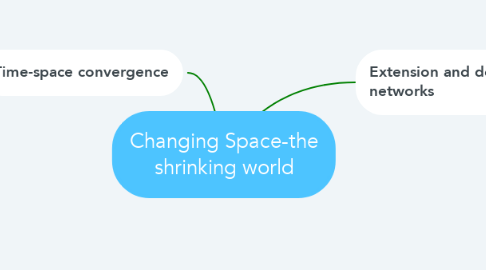
1. Time-space convergence
1.1. Types of transport
1.1.1. Sea
1.1.1.1. Advantages
1.1.1.1.1. Cheaper over long distances
1.1.1.1.2. No cost in building the route
1.1.1.1.3. Good for bulky, low-cost goods, e.g. coals, ores, grains
1.1.1.1.4. Costs spread over a large cargo
1.1.1.2. Disadvantages
1.1.1.2.1. Slow
1.1.1.2.2. Limited routes to deep-water ports
1.1.1.2.3. Ships expensive to build and maintain
1.1.1.2.4. Environmental problems, especially pollution
1.1.1.2.5. Ports take up grea
1.1.1.3. Air
1.1.1.3.1. Advantages
1.1.1.3.2. Disadvantages
1.2. Major developments in transport technology
1.2.1. The major breakthrough came with the invention and application of steam power and the use of iron and steel for trains, railway tracks and ocean-going vessels.
2. Extension and density of networks
2.1. Population size
2.1.1. it is the number of individual organisms in a population.
2.1.1.1. Countries with small populations, such as Greenland, are unlikely to generate a large number of calls.
2.2. Population density
2.2.1. it is a measurement of population per unit area or unit volume.
2.2.1.1. Within the USA, for example, there is a small flow to and from Alaska but a very large flow to and from northeastern USA.
2.3. Wealth
2.3.1. it is the abundance of valuable resources or valuable material possessions for a country.
2.3.1.1. Wealthy countries, such as Japan and the USA, can afford more phones than poorer countries in Africa.
2.4. Lack of landline infrastructure
2.4.1. in Africa this has led to mobile phones being far more popular
2.4.1.1. Africa is one of the fastest growing markets for mobile phones, and landlines may therefore never achieve the same prominence here as in other regions.
2.5. Trading partners
2.5.1. countries within a trading bloc, such as the EU, are likely to generate large volumes of calls.
2.6. TNC or MNC activities
2.6.1. companies with offices and factories in several different countries are likely to create large volumes of calls between those countries.
2.7. Migration
2.7.1. there is likely to be a high volume of calls between the area a migrant moves to and their home country.
2.7.1.1. However, the country of origin may be relatively poor and have relatively few phones.
2.8. Colonial history
2.8.1. it is likely that there will be political and historic ties between a former colonial power and its former colonies.
2.8.1.1. The UK and the former British Empire is a good example.
2.9. Language
2.9.1. it is is the ability to acquire and use complex systems of communication, particularly the human ability to do so.
2.9.1.1. The volume of calls is likely to be greater between countries that share the same language.
2.10. The digital divide
2.10.1. inequality in the ICT network infrastructure and distribution of the IT knowledge, skills and resources necessary to access online services and information among different sections of a modern society.
